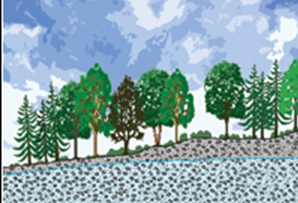Geographical Issues:Pakistan
This is a collection of articles archived for the excellence of their content. Readers will be able to edit existing articles and post new articles directly |
Geographical Issues
May 28, 2006
EXCERPTS: The fallen tree
This is a journal comprising research papers by various geophysicists on a range of geographical issues affecting Pakistan
Saifullah Khan and Mahmood-ul-Hasan show how planting eucalyptus trees is not profitable.
The term eucalyptus has been derived from two Greek words: “Eu” and “Kalypta”. Eu means “good” and Kalypta means “cover” and is generally termed as “good cover”. The name eucalyptus normally refers to the little cap (operculum) covering an unopened flower. As regarding their habits, the eucalpytus is described as an evergreen tree, shrub, mallee and marlock. The height of various species of eucalyptus varies from 4.57 metres to 97.53 metres or 15 to 320 feet. Banks and Daniel first introduced it in 1770 on the shore of Botany Bay on the eastern coast of Australia. The first description of the plant was published in 1789, and French botanist Heriter proposed the name “eucalyptus”. The subsequent outstanding workers on the species are Blackely (1934), Grender and Watsson (1948), Rogler (1953), and Chappendal (1973).
In the Indian subcontinent it was introduced in Punjab by Capt Dryas in 1860. Subsequently in 1952 Parker planted it in the plain and hills of the northwestern part of the subcontinent ...
As eucalyptus generally causes evaporatation of a high ratio of groundwater into the atmosphere and lowers the watertable level, the French introduced it in waterlogged and saline areas. In Pakistan, it is mostly planted on mountain slopes that have a humid and sub-humid climate. The plant is highly effective to rock reservoirs and groundwater. Therefore, it is more important to evaluate the impact of eucalyptus on mountain slopes, groundwater, and its contribution to the lowering of the watertable level ...
Slope and depth of the watertable
Water is a basic requirement of human life and its properties in three physical states make it the most useful of compounds. The source, which keeps water in balance is the hydrological cycle. It is defined as “the circulation of water from oceans to air and the return to the oceans, entailing residence of varying duration in life forms, freshwater, ice accumulation, or as groundwater.” A considerable amount of water received from rain or snow percolates downward into the soil and into the rocks filling up joints and pore spaces and forms what is known as groundwater. Water that seeps through the ground moves downward under the force of gravity until it reaches the impermeable layer of rocks through which it cannot pass ... The surface of the saturated area is called the water table. This is a key source in the balancing of the hydrological cycle of an area.
Eucalyptus and ground water
Eucalyptus causes evaporatation of a high amount of groundwater into the atmosphere and therefore it has been introduced for waterlogged areas. Due to the high rate of evapotranspiration, the tree has certain effects on rocks and natural water reservoirs ...
The watertable of a study area showed more than a three feet decline, from 1995 to 2000. Some respondents were of the opinion that this fall in the watertable, groundwater and flow of water from the springs was generally, caused by the plantation of eucalyptus trees on the mountain slopes. Evidently, eucalyptus is called a solar tube well which discharges most of the groundwater into the atmosphere. Consequently it is more dangerous to all those sources which serve as storage of incoming water particularly into fire rock reservoirs.
As the watertable decreases, the water stored in interstices and rock reservoirs comes out in the form of springs and flows toward the intermediate zone of aeration after absorption by the earth’s surface and helps in the recharging of the watertable.
The Forest Department of Pakistan carried out the plantation of eucalyptus trees on mountain slopes in 1995, which began to cause the evaporatation of 45 to 52 litres of of groundwater per day into the atmosphere through evapotranspiration and left the rock reservoirs dry. This change in rock reservoirs not only affected the flow of water from springs, but also caused a change in the watertable as well as in the level of running water.
The three springs of the village where the trees were planted, having mountainous location are completely covered by eucalyptus and because of this one of them has completely dried, while the rest of the springs show an 80 per cent decrease in the flow of water. Another spring located at Shandala, with no eucalyptus trees surrounding it showed no change. This comparative study reveals that the dryness of springs along with the decrease in the amount of annual precipitation is also due to the growth of eucalyptus trees in the area.
The mountainous region of Pakistan, particularly the northern territory is the source of our water resources. Melting of glaciers, springs and rainfall serve as a source of running water. Due to a high rate of evapotranspiration caused by eucalyptus from the rock reservoirs, the springs have become dry and the area has lost its share of spring water in the river. This proves that the eucalyptus tree is more dangerous to the watertable, groundwater, rock reservoirs and springs and serious consideration must be given to the fact that the plantation of eucalyptus be stopped on the mountain slopes as well as in the lowlands of Pakistan ...
The basic purpose of planting eucalyptus was to save the mountains from intensive soil erosion, while the landlords of the area provided land for the purpose to keep the mountains in their own hands. Against the involvement of landlords, the common inhabitants resisted not only the plantation of eucalyptus but also of the other trees to reduce the hold of the landlords in the area. Another reason of the unwillingness to plant eucalyptus is the high rate of evapotranspiration of groundwater into the atmosphere. The tree also has a poor market demand, low domestic use, and gives very little shade. Furthermore, most of the respondents show a willingness to plant deodar, shisham, bakyan, pines, etc., which besides being suitable to the climate of the mountain area are also less affective to the groundwater.
Impact of agriculture
Before 1995, the people of Swat cultivated crops producing over a 100tons per acre on the Ghazibaba Serai and other spring and rainfed areas. Due to the decline in watertable levels and a decrease in the flow of water from springs, the land dried out completely which is why the yield per acre of the rabi and kharif crops has decreased.
Excerpted with permission from
Journal Geographic: The Journal of the Pakistan Geographical Association
Edited by Ahsan Ullah
Available with Department of Geography,
S.M. Government Arts & Commerce College,
Shahrah-i-Ataturk, Karachi-74200
and Department of Geography, University of Karachi
56pp. Price not listed
Saifullah Khan and Mahmood-ul-Hasan are associated with the University of Peshawar’s department of Geography that is involved in urban and regional planning.


